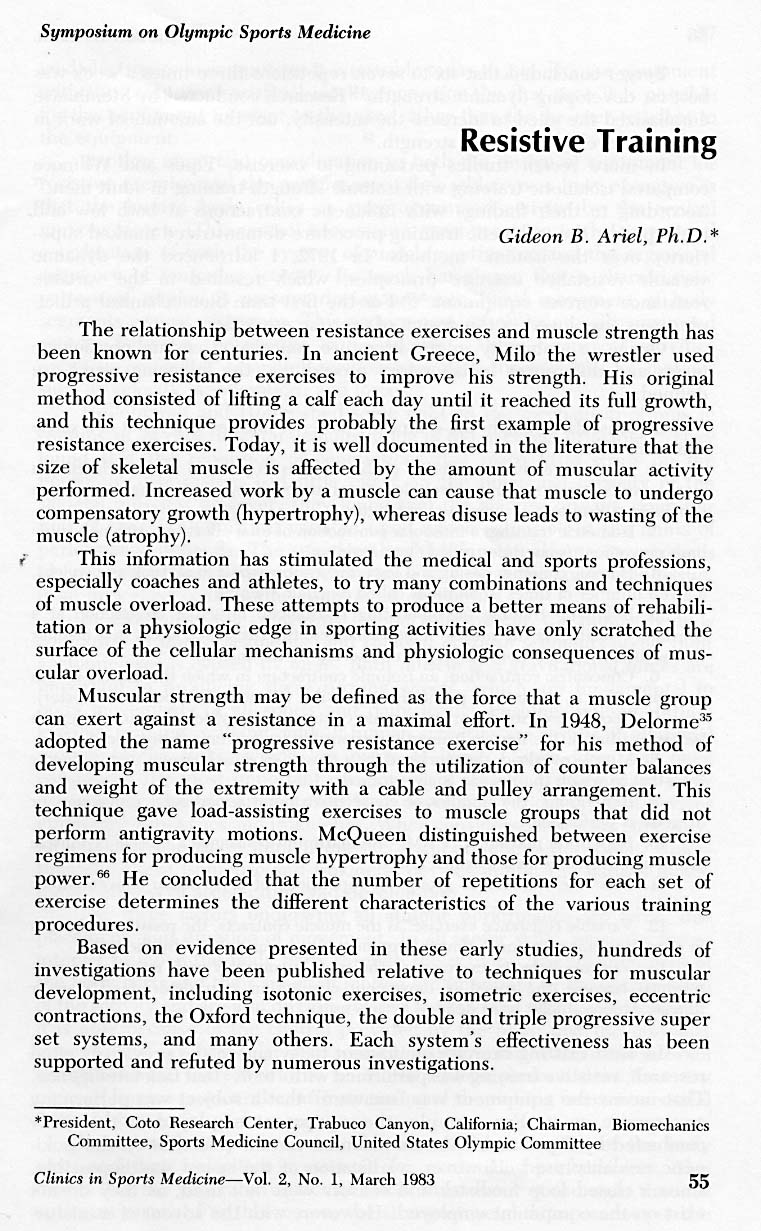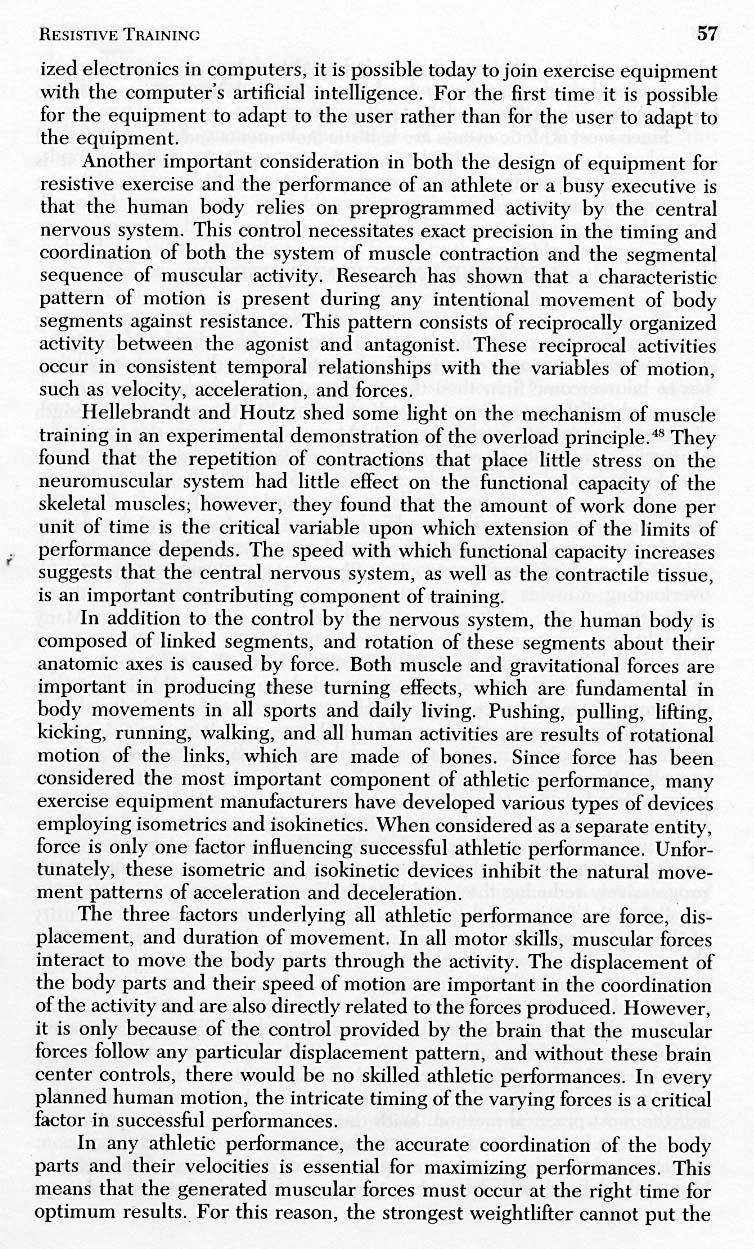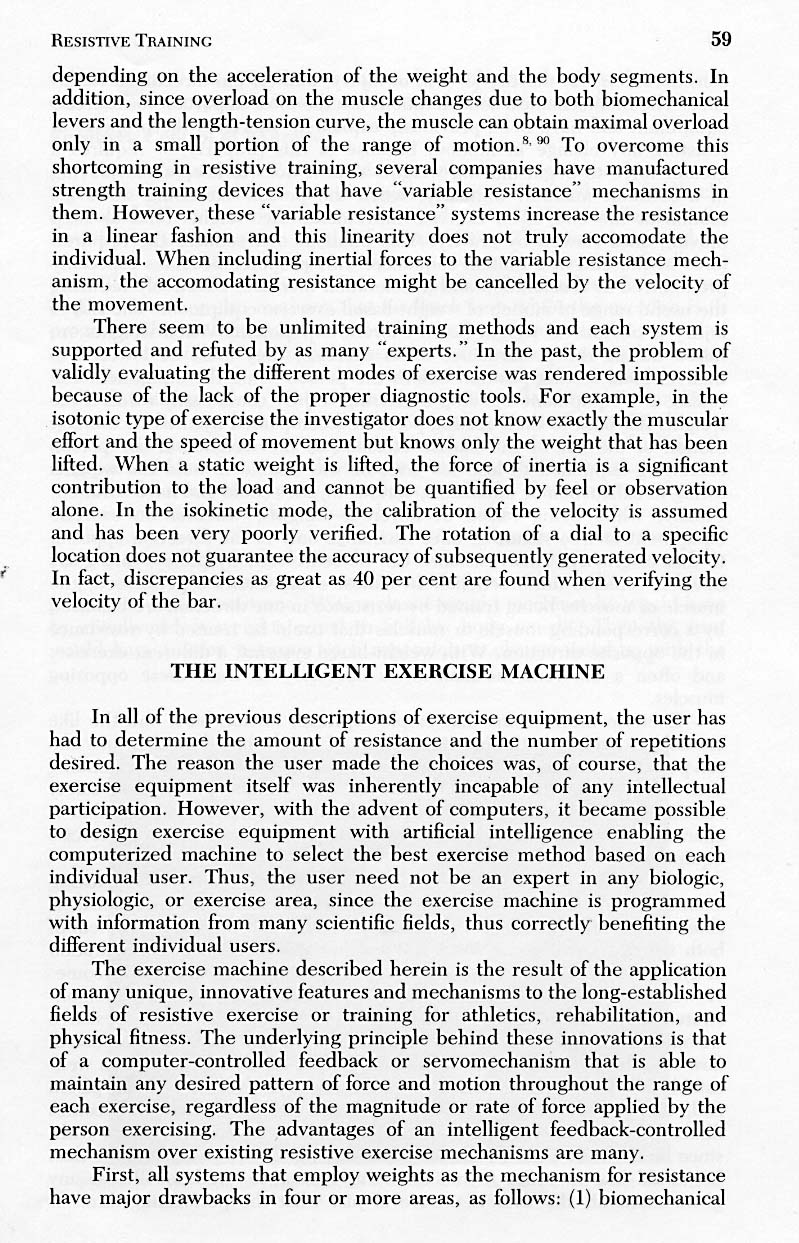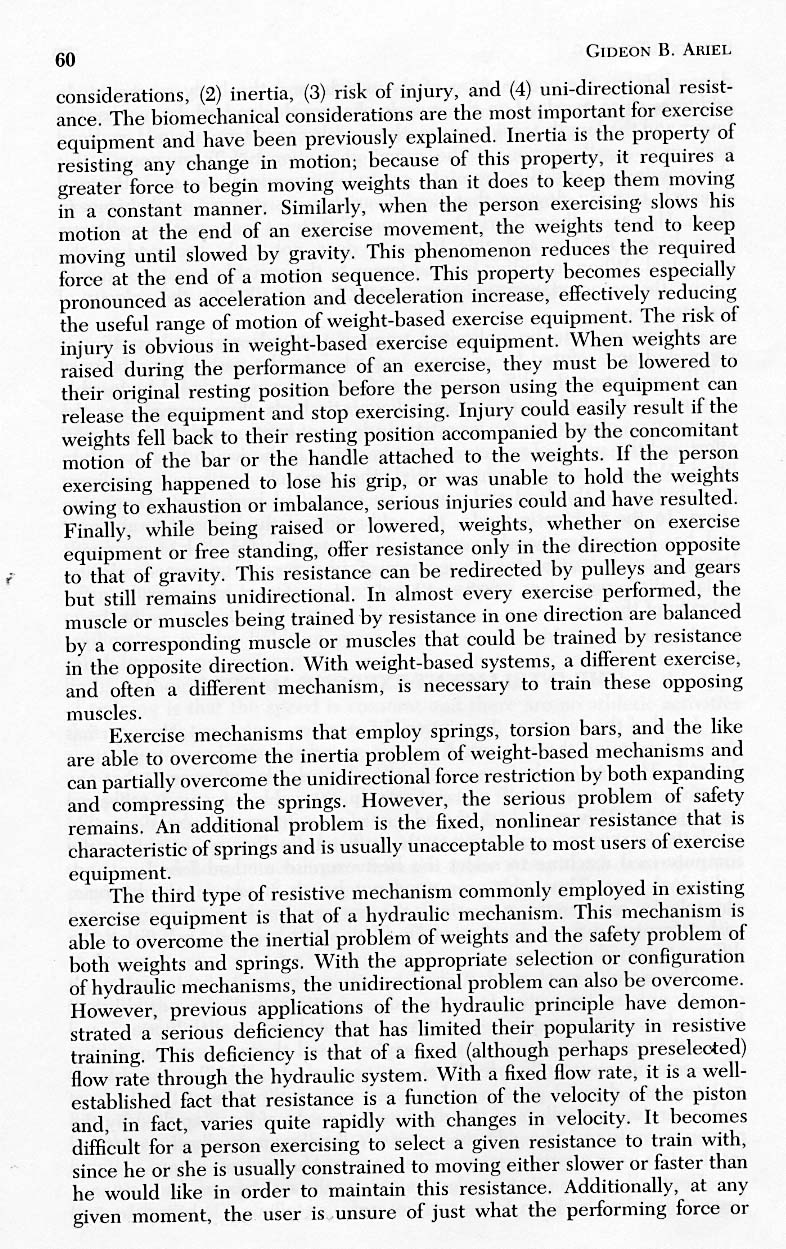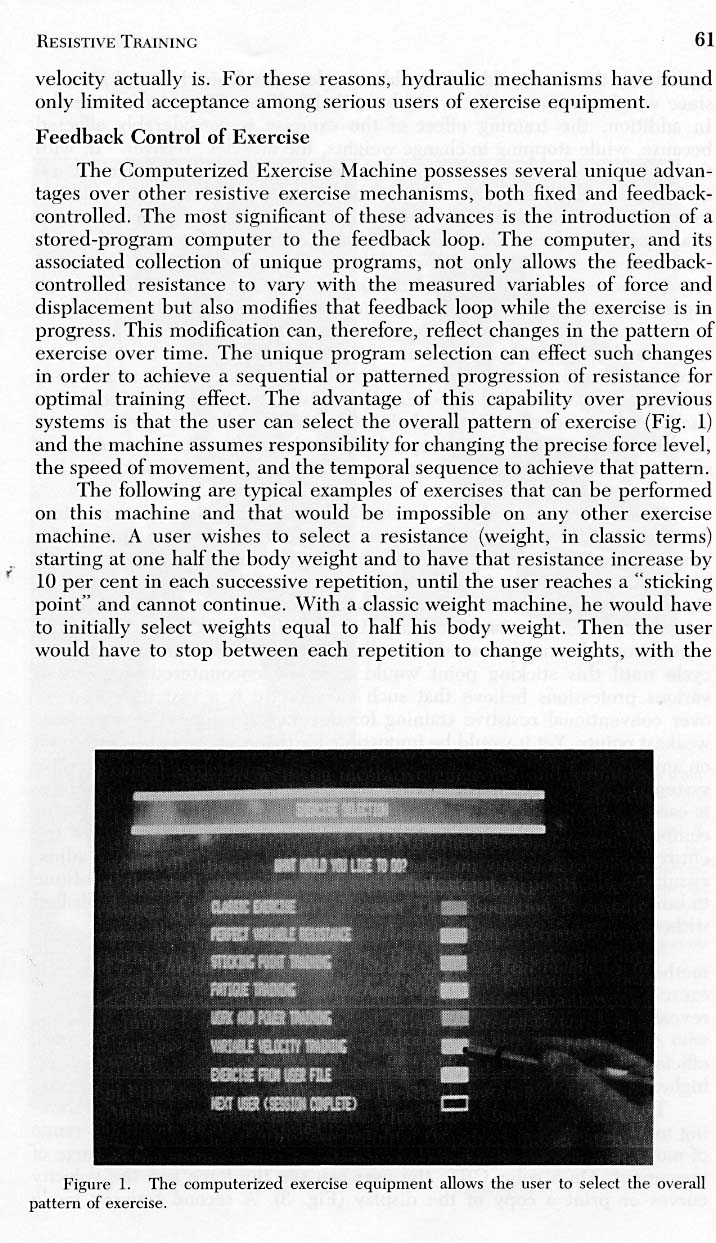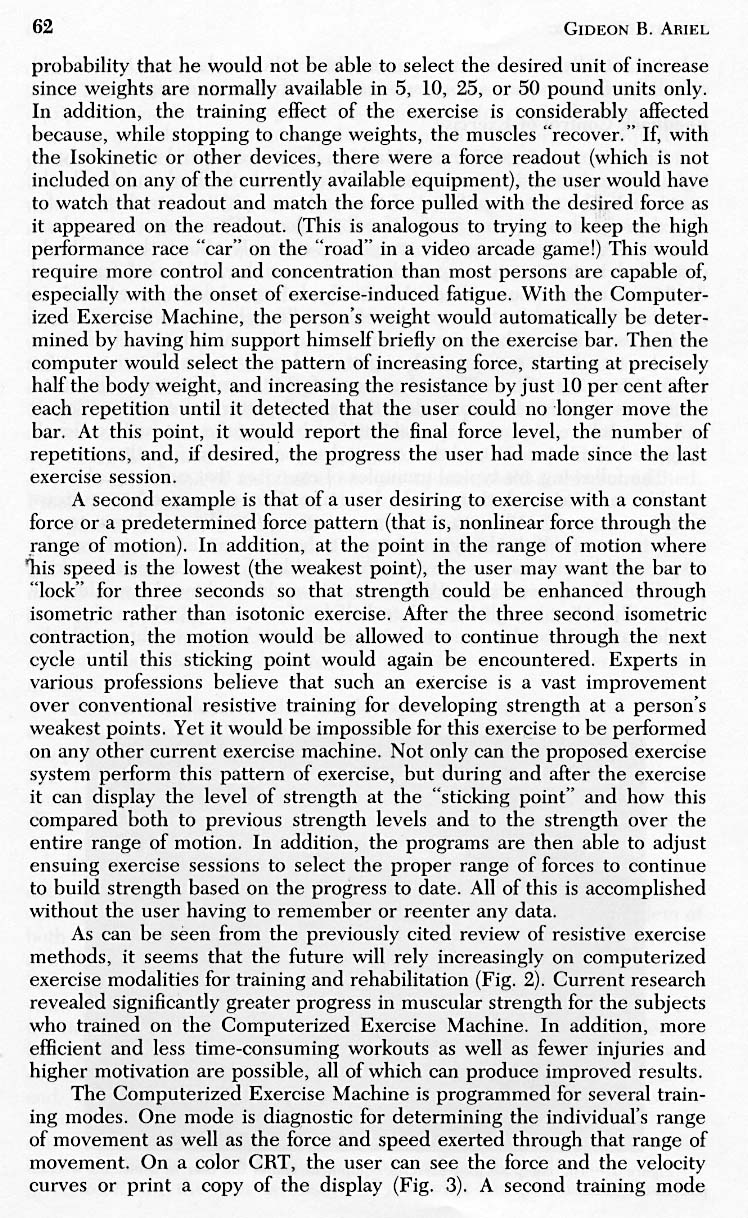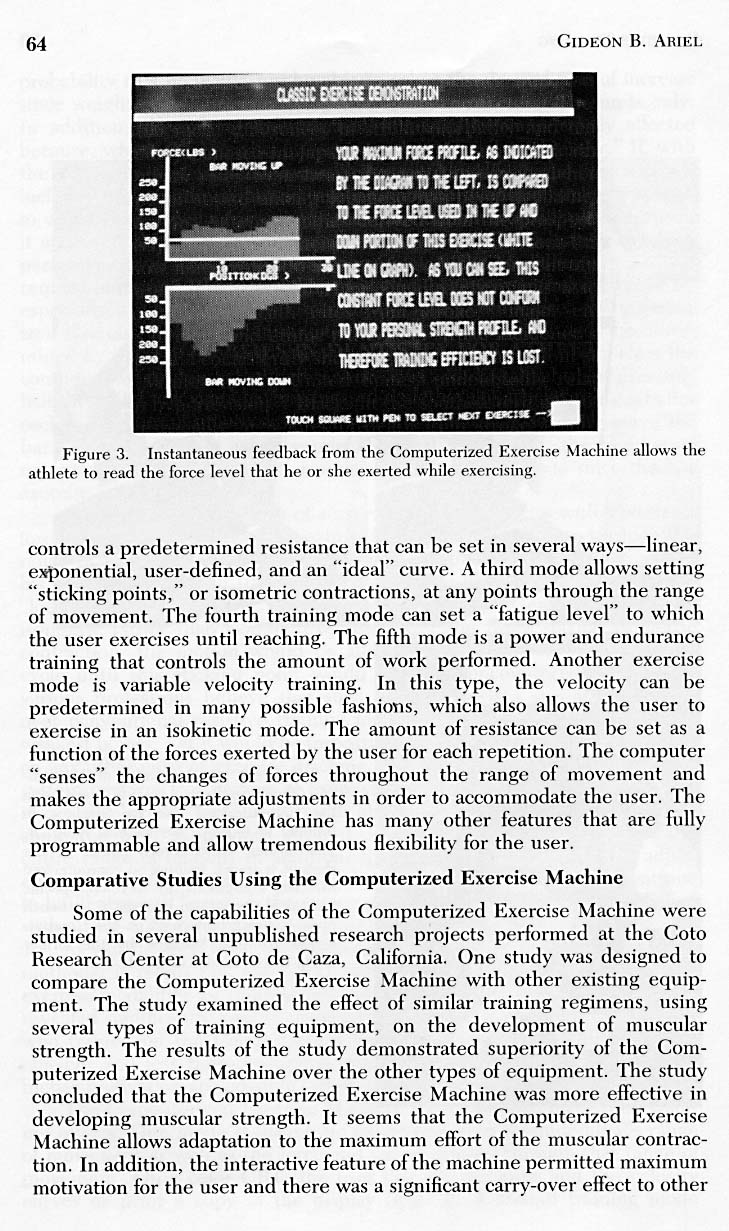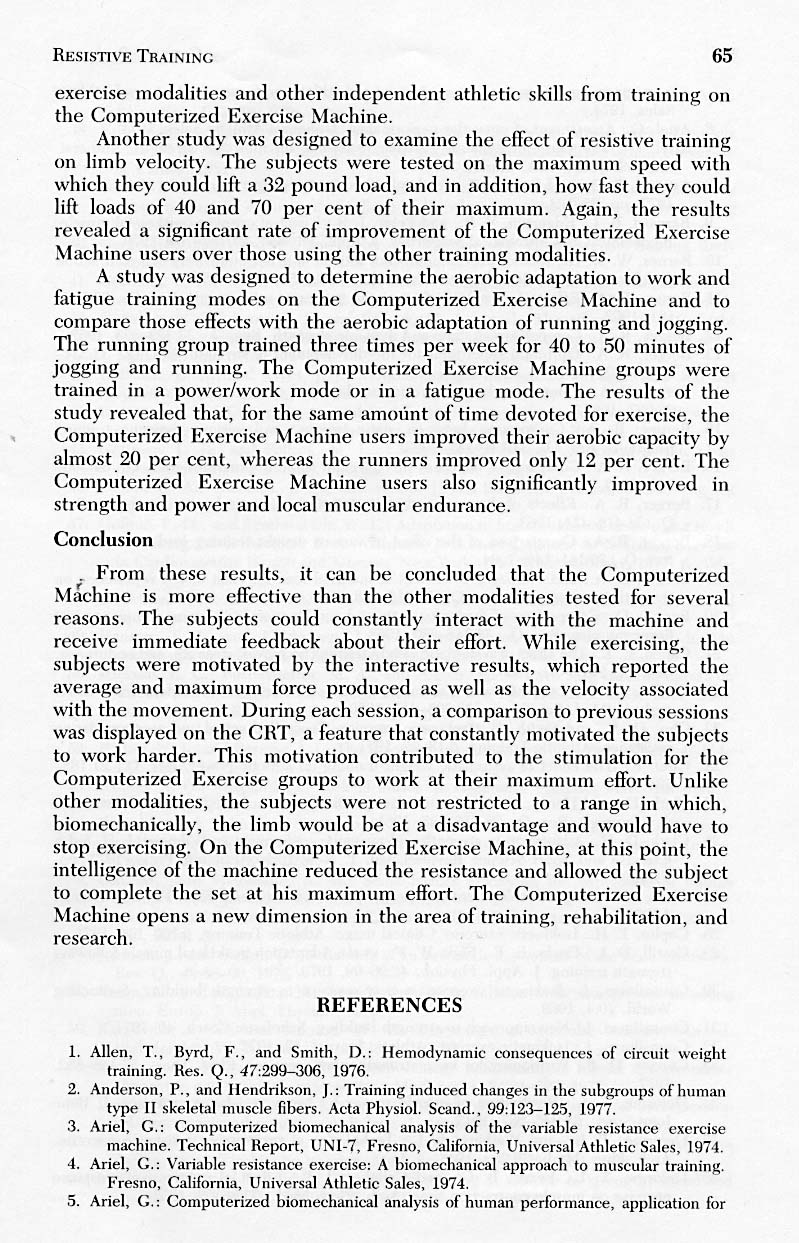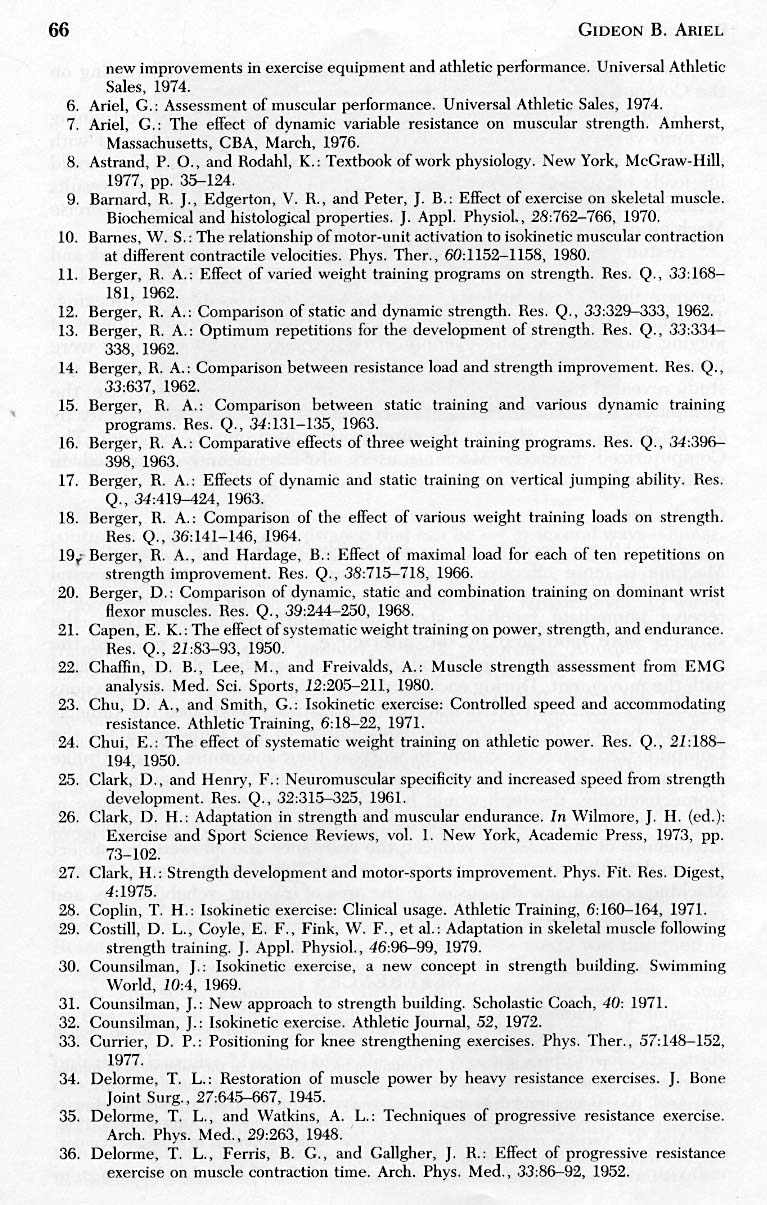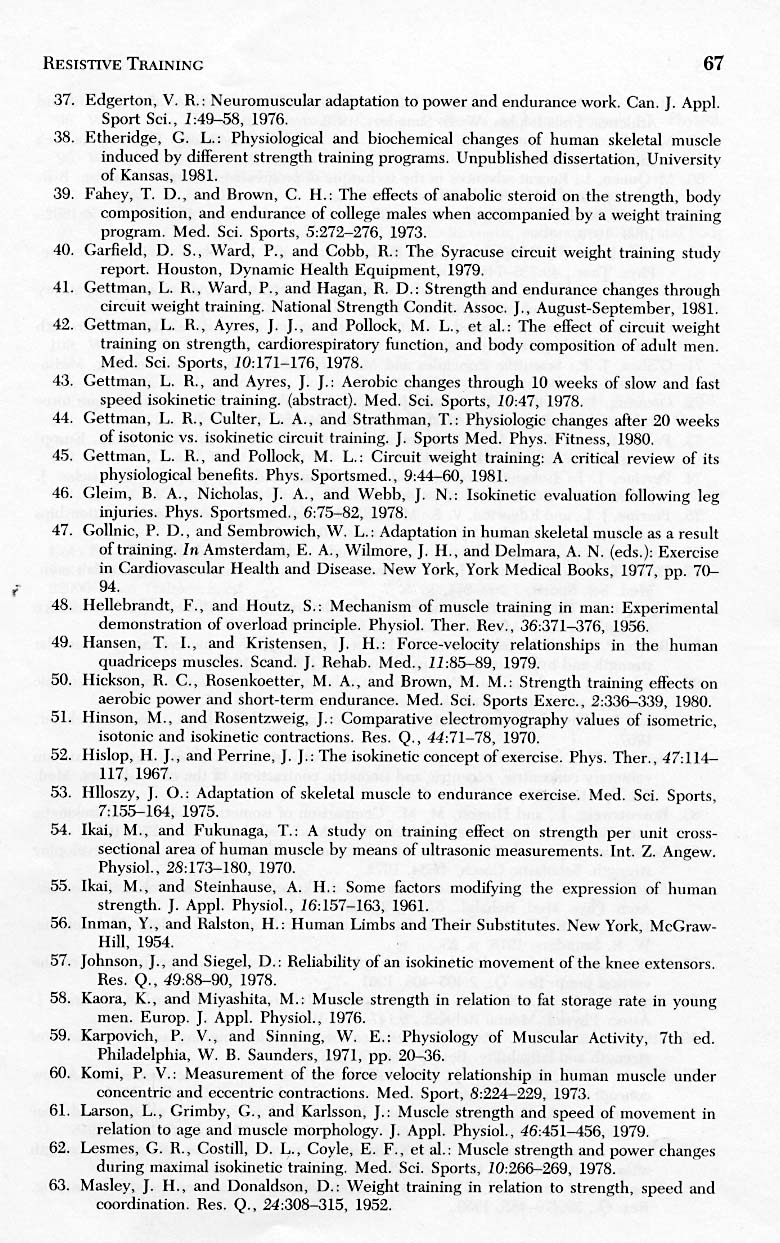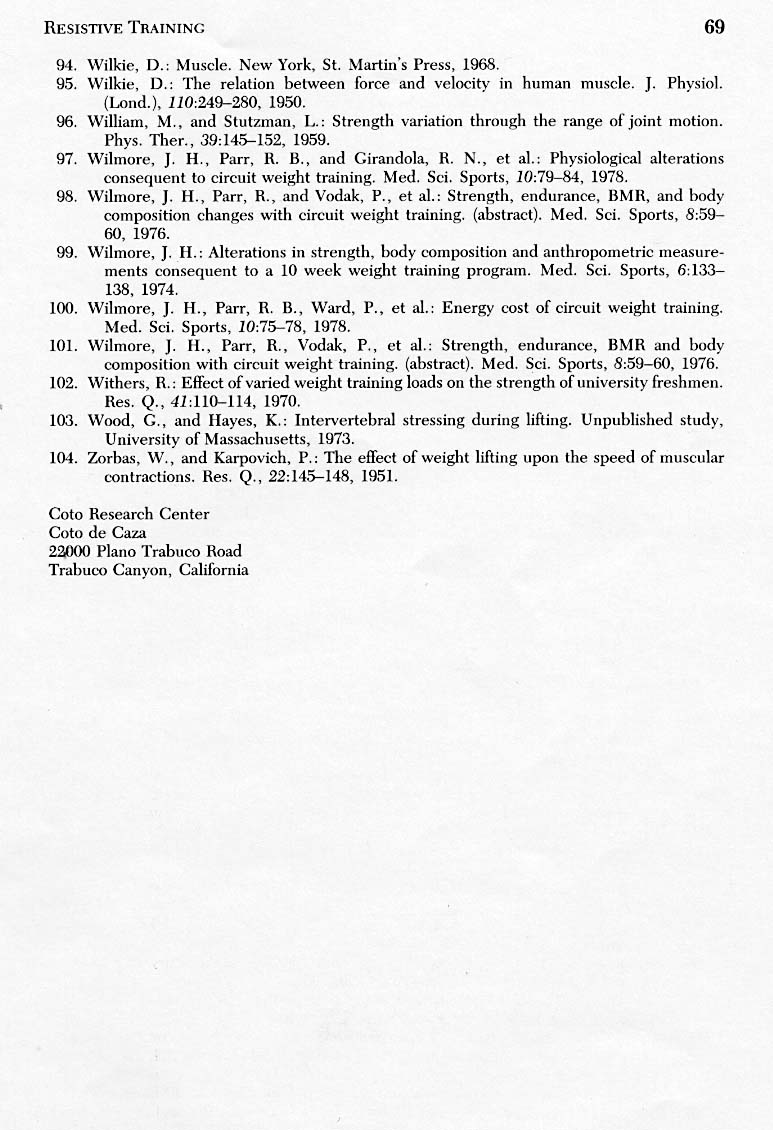Resistive Training
The relationship between resistance exercises and muscle strength
By Gideon Ariel in Clinics in Sports Medicine on Thursday, March 17, 1983
Resistive Training: A Comprehensive Study by Gideon B. Ariel, PhD
This article, published in the Clinics in Sports Medicine journal in March 1983, explores the relationship between resistance exercises and muscle strength. The author, Gideon B. Ariel, PhD, delves into the history of resistive training, dating back to ancient Greece, and discusses the various techniques and methods used to increase muscle strength and size.
The article highlights the importance of muscular activity in influencing the size of skeletal muscle. Increased work by a muscle can cause compensatory growth (hypertrophy), while disuse leads to muscle wasting (atrophy). Ariel discusses various techniques for muscle overload, including isotonic exercises, isometric exercises, eccentric contractions, and more.
The author also defines key terms related to resistive training, such as muscular strength, muscular endurance, isometric training, isotonic training, isokinetic training, and others. He also discusses the role of the central nervous system in controlling muscle contraction and the sequence of muscular activity.
The article further explores the drawbacks of current isotonic types of resistive exercises and the potential of computerized machines in providing a more personalized and effective training regimen. Ariel concludes by discussing the advantages of an intelligent feedback-controlled mechanism over existing resistive exercise mechanisms.
This comprehensive study provides valuable insights into the science of resistive training, offering a deeper understanding of the mechanisms behind muscle growth and strength development.
The article discusses the advantages of the Computerized Exercise Machine over other resistive exercise mechanisms. The machine uses a stored-program computer to modify the feedback loop during exercise, allowing for changes in the pattern of exercise over time. This allows for a sequential or patterned progression of resistance for optimal training effect. The machine can also adjust the force level, speed of movement, and temporal sequence to achieve the desired exercise pattern. The article provides examples of exercises that can be performed on this machine that would be impossible on any other exercise machine. The article concludes that the Computerized Exercise Machine is more effective in developing muscular strength and improving aerobic capacity than other exercise modalities.
This article is a comprehensive review of various studies conducted on resistive training and its effects on human physiology. The studies range from the specificity of speed of exercise, isokinetic exercise, effects of weight training on circulorespiratory endurance, and the development of strength and muscle hypertrophy. The article also explores the physiological basis of human performance, the comparison of isometric, isotonic, and isokinetic exercises, and the effects of various training programs on speed of swimming. The studies also delve into the relationship between force and velocity in human muscle, strength variation through the range of joint motion, and the physiological alterations consequent to circuit weight training. The article provides a rich source of information for those interested in the science of strength and fitness training.
Tip: use the left and right arrow keys
Resistive Training
Gideon B. Ariel, PhD
Reprinted from
Clinics in Sports Medicine
VOLUME 2, NUMBER 1, MARCH 1983
Symposium on Olympic Sports Medicine
Resistive Training
Gideon B. Ariel, Ph.D.*
The relationship between resistance exercises and muscle strength has been known for centuries. In ancient Greece, Milo the wrestler used progressive resistance exercises to improve his strength. IIis original method consisted of lifting a calf each day until it reached its full growth, and this technique provides probably the first example of progressive resistance exercises. Today, it is well documented in the literature that the size of skeletal muscle is affected by the amount of muscular activity perfiwmed. Increased work by a muscle can cause that muscle to undergo compensatory growth (hypertrophy), whereas disuse leads to wasting of the muscle (atrophy).
This information has stimulated the medical and sports professions, especially coaches and athletes, to try many combinations and techniques of muscle overload. These attempts to produce a better means of rehabilitation or a physiologic edge in sporting activities have only scratched the surface of the cellular mechanisms and physiologic consequences of muscular overload.
Muscular strength may be defined as the force that a muscle group can exert against a resistance in a maximal effort. In 1948, .Delorme'' adopted the name "progressive resistance exercise" for his method of developing muscular strength through the utilization of counter balances and weight of the extremity with a cable and pulley arrangement. This technique gave load-assisting exercises to muscle groups that did not perform antigravity motions. McQueen distinguished between exercise regimens for producing muscle hypertrophy and those for producing muscle power.' He concluded that the number of repetitions for each set of' exercise determines the different characteristics of the various training procedures.
Based on evidence presented in these early studies, hundreds of investigations have been published relative to techniques fin- muscular development, including isotonic exercises, isometric exercises, eccentric contractions, the Oxford technique, the double and triple progressive super set systems, and many others. Each system's effectiveness has been supported and refuted by numerous investigations.
*President. Coto Research Center, Trabuco Canyon, California; Chairman, Biomechanics Committee, Sports Medicine Council, United States Olympic Committee
Clinics in Sports Medicine�Vol. 2, No. 1, March 1983 55
56 GIDEON B. ARIEL
Berger concluded that six to seven repetitions three times a week was best for developing dynamic strength.'' Research conducted by Steinhause emphasized the need to increase the intensity, not the amount, of work in order to develop maximum strength'
In more recent studies pertaining to exercise, Pipes and ^ Vilmore compared isokinetic training with isotonic strength training in adult men." According to their findings with isokinetic contractions at both low and high speeds, the isokinetic training procedure demonstrated marked superiority over the isotonic methods. In 1972, I introduced the dynamic variable resistance exercise principles, which resulted in the variable resistance exercise equipment.' For the first time biomechanical principles were employed in the design of exercise equipment.
Owing to ambiguity in the literature concerning certain physiologic terms and differences in laboratory procedures, the following terms are defined:
- Muscular strength: the contractile power of muscles as a result of a single maximum effort.
Muscular endurance: ability of the muscles to perform work by holding a maximum contraction for a given length of time or by continuing to move a submaximal load to a certain level of fatigue.
Isometric training: a muscular contraction of total effort but with no visible limb movement (sometimes called static training).
Isotonic training: raising and lowering a submaximal load, such as a weight, a given number of times (sometimes called dynamic training).
Isokinetic training (accomodating resistance): muscular contraction at a constant velocity. As the muscle length changes, the resistance alters in a manner that is directly proportional to the force exerted by the muscle.
Concentric contraction: an isotonic contraction in which the muscle length decreases (that is, the muscle primarily responsible for movement becomes shorter).
Eccentric contraction: an isotonic contraction in which the muscle length increases (that is, the muscle primarily responsible for movement becomes longer).
Muscle overload: the workload for a muscle or muscle group that is greater than that to which the muscle is accustomed.
Repetitions: the number of consecutive times a particular movement or exercise is performed.
Repetition maximum (1 RM): the maximum resistance a muscle or muscle group can overcome in a maximal effort.
Sets: the number of groups of repetitions of a particular movement or exercise.
Variable resistance exercise: as the muscle contracts, the resistance changes in a predetermined manner (linear, exponentially, or as defined by the user).
Variable velocity exercise: as the muscle contracts with maximal or sub-maximal tension, the speed of movement changes in a predetermined manner (linear, exponentially, or as defined by the user).
In most existing exercise equipment today and in the previously cited research, resistive training was performed with "tools" that lack intelligence. That means the equipment was "unaware" that a subject was performing an exercise on it. For example, the equipment employed in the study conducted by Pipes and Wilmore assumed certain velocities on the isokinetic modality used. However, verification of the speed was impossible, since a closed loop feedback and sensors were not used, as they do not exist on the equipment employed. However, with the advent of' miniatur-
RESISTIVE TR.AINiN(; 57
ized electronics in computers, it is possible today to join exercise equipment with the computer's artificial intelligence. For the first time it is possible for the equipment to adapt to the user rather than for the user to adapt to the equipment.
Another important consideration in both the design of equipment for resistive exercise and the performance of an athlete or a busy executive is that the human body relies on preprogrammed activity by the central nervous system. This control necessitates exact precision in the timing and coordination of both the system of muscle contraction and the segmental sequence of muscular activity. Research has shown that a characteristic pattern of motion is present during any intentional movement of body segments against resistance. This pattern consists of reciprocally organized activity between the agonist and antagonist. These reciprocal activities occur in consistent temporal relationships with the variables of motion, such as velocity, acceleration, and forces.
IIellebrandt and Houtz shed some light on the mechanism of muscle training in an experimental demonstration of the overload principle." They found that the repetition of contractions that place little stress on the neuromuscular system had little effect on the functional capacity of the skeletal muscles; however, they found that the amount of work done per unit of time is the critical variable upon which extension of the limits of performance depends. The speed with which functional capacity increases suggests that the central nervous system, as well as the contractile tissue, is an important contributing component of training.
In addition to the control by the nervous system, the human body is composed of linked segments, and rotation of these segments about their anatomic axes is caused by force. Both muscle and gravitational forces are important in producing these turning effects, which are fundamental in body movements in all sports and daily living. Pushing, pulling, lifting, kicking, running, walking, and all human activities are results of rotational motion of the links, which are made of bones. Since force has been considered the most important component of athletic performance, many exercise equipment manufacturers have developed various types of devices employing isometrics and isokinetics. When considered as a separate entity, force is only one factor influencing successful athletic performance. Unfortunatcly, these isometric and isokinetic devices inhibit the natural movement patterns of acceleration and deceleration.
The three factors underlying all athletic performance are force, displacement, and duration of movement. In all motor skills, muscular forces interact to move the body parts through the activity. The displacement of the body parts and their speed of motion are important in the coordination of the activity and are also directly related to the forces produced. However, it is only because of the control provided by the brain that the muscular forces follow any particular displacement pattern, and without these brain center controls, there would be no skilled athletic performances. In every planned human motion, the intricate timing of the varying forces is a critical factor in successful performances.
In any athletic performance, the accurate coordination of the body parts and their velocities is essential for maximizing performances. This means that the generated muscular forces must occur at the right time for optimum results. For this reason, the strongest weightlifter cannot put the
58 GIDEON B. AEIEI.
shot as far as the experienced shotputter. Although the weightlifter possesses greater muscular force, he has not trained his brain centers to produce the correct forces at the appropriate time.
Since most athletic events are ballistic movements and since the neural control of these patterns differs from slow controlled movements, it is essential that training routines employ programmable motions to suit specific movements.
RESISTIVE EXERCISING METHODS
There is a significant difference between various resistive training methods. As far as isotonic and isokinetic exercises are concerned, for example, in the isotonic exercises the inertia, that is, the initial resistance, has to be overcome first, then the execution of the movement progresses. The weight of the resistance cannot be heavier than the maximum strength of the weakest muscle acting in a particular movement or else the movement cannot be completed. Consequently, the amount of force generated by the muscles during an isotonic contraction does not maintain maximum tension throughout the entire range of motion. In an isokinetically loaded muscle, the desired speed of movement occurs almost immediately and the muscle is able to generate a maximal force under a controlled and specifically selected speed of contraction. The use of the isokinetic principle for overloading muscles to attain their maximal power output has direct applications in the fields of sport medicine and athletic training. Many rehabilitation programs utilize isokinetic training to recondition injured limbs to their full range of motion. The unfortunate drawback to this type of training is that the speed is constant and there are no athletic activities that are performed at a constant velocity.
In isotonic resistive training, if more than one repetition is to be used, one must use submaximal overload on the initial contractions in order to complete the required repetitions. Otherwise, the entire regimen will not be completed, owing to fatigue. Berger and Hardage studied this problem by training two groups of men with 10 RM.'S One group trained following the standard Berger technique while the other group used one repetition maximum fbr each of the ten repetitions. This was accomplished by progressively reducing the weight for the next repetition in a manner that paralleled the fatigue of the muscle. The results showed that the intensity of the work seemed to be the important factor in strength increases, since the maximal overload group showed significantly greater strength gains than did the standard l0 RM group.
Based on these findings, it would seem appropriate to assume that a modality that can adjust the resistance so that it parallels fatigue to allow the maximum RM for each repetition would be superior to the currently available equipment. Berger accomplished this function by removing weight from the bar while the subject trained. This is neither the most convenient nor the most practical method. With the aid of the modern computer, this function can be performed automatically.
Another drawback with current isotonic types of resistive exercises is that with the aid of inertia, due to the motion, the resistance changes
RESISTIVE TRAINING 59
depending on the acceleration of the weight and the body segments. In addition, since overload on the muscle changes due to both biomechanical levers and the length-tension curve, the muscle can obtain maximal overload only in a small portion of the range of motion." 9� To overcome this shortcoming in resistive training, several companies have manufactured strength training devices that have "variable resistance" mechanisms in them. However, these "variable resistance" systems increase the resistance in a linear fashion and this linearity does not truly accomodate the individual. When including inertial forces to the variable resistance mechanism, the accomodating resistance might be cancelled by the velocity of the movement.
There seem to be unlimited training methods and each system is supported and refuted by as many "experts." In the past, the problem of validly evaluating the different modes of exercise was rendered impossible because of the lack of the proper diagnostic tools. For example, in the isotonic type of exercise the investigator does not know exactly the muscular effort and the speed of movement but knows only the weight that has been lifted. When a static weight is lifted, the force of inertia is a significant contribution to the load and cannot be quantified by feel or observation alone. In the isokinetic mode, the calibration of the velocity is assumed and has been very poorly verified. The rotation of a dial to a specific location does not guarantee the accuracy of subsequently generated velocity. In fact, discrepancies as great as 40 per cent are found when verifying the velocity of the bar.
THE INTELLIGENT EXERCISE MACHINE
In all of the previous descriptions of exercise equipment, the user has had to determine the amount of resistance and the number of repetitions desired. The reason the user made the choices was, of course, that the exercise equipment itself was inherently incapable of any intellectual participation. However, with the advent of computers, it became possible to design exercise equipment with artificial intelligence enabling the computerized machine to select the best exercise method based on each individual user. Thus, the user need not be an expert in any biologic, physiologic, or exercise area, since the exercise machine is programmed with information from many scientific fields, thus correctly benefiting the different individual users.
The exercise machine described herein is the result of the application of many unique, innovative features and mechanisms to the long-established fields of resistive exercise or training for athletics, rehabilitation, and physical fitness. The underlying principle behind these innovations is that of a computer-controlled feedback or servomechanism that is able to maintain any desired pattern of force and motion throughout the range of each exercise, regardless of the magnitude or rate of force applied by the person exercising. The advantages of an intelligent feedback-controlled mechanism over existing resistive exercise mechanisms are many.
First, all systems that employ weights as the mechanism for resistance have major drawbacks in four or more areas, as follows: (1) biomechanical
60 C-DEON B. Alum.
considerations, (2) inertia, (3) risk of injury, and (4) uni-directional resistance. The biomechanical considerations are the most important fin- exercise equipment and have been previously explained. Inertia is the property of resisting any change in motion; because of this property, it requires a greater force to begin moving weights than it does to keep them moving in a constant manner. Similarly, when the person exercising slows his motion at the end of an exercise movement, the weights tend to keep moving until slowed by gravity. This phenomenon reduces the required force at the end of a motion sequence. This property becomes especially pronounced as acceleration and deceleration increase, effectively reducing the useful range of motion of weight-based exercise equipment. The risk of injury is obvious in weight-based exercise equipment. When weights are raised during the performance of an exercise, they must be lowered to their original resting position before the person using the equipment can release the equipment and stop exercising. Injury could easily result if the weights fell back to their resting position accompanied by the concomitant motion of the bar or the handle attached to the weights. If the person exercising happened to lose his grip, or was unable to hold the weights owing to exhaustion or imbalance, serious injuries could and have resulted. Finally, while being raised or lowered, weights, whether on exercise equipment or free standing, offer resistance only in the direction opposite to that of' gravity. This resistance can be redirected by pulleys and gears but still remains unidirectional. In almost every exercise performed, the muscle or muscles being trained by resistance in one direction are balanced by a corresponding muscle or muscles that could be trained by resistance in the opposite direction. With weight-based systems, a different exercise, and often a different mechanism, is necessary to train these opposing muscles.
Exercise mechanisms that employ springs, torsion bars, and the like are able to overcome the inertia problem of weight-based mechanisms and can partially overcome the unidirectional fierce restriction by both expanding and compressing the springs. However, the serious problem of safety remains. An additional problem is the fixed, nonlinear resistance that is characteristic of springs and is usually unacceptable to most users of exercise equipment.
The third type of resistive mechanism commonly employed in existing exercise equipment is that of a hydraulic mechanism. This mechanism is able to overcome the inertial problem of weights and the safety problem of both weights and springs. With the appropriate selection or configuration of hydraulic mechanisms, the unidirectional problem can also be overcome. However, previous applications of the hydraulic principle have demonstrated a serious deficiency that has limited their popularity in resistive training. This deficiency is that of a fixed (although perhaps preselected) flow rate through the hydraulic system. With a fixed flow rate, it is a well-established fact that resistance is a function of the velocity of the piston and, in fact, varies quite rapidly with changes in velocity. It becomes difficult for a person exercising to select a given resistance to train with, since he or she is usually constrained to moving either slower or faster than he would like in order to maintain this resistance. Additionally, at any given moment, the user is unsure of just what the performing force or
RESISTIVE TRAINING 61
velocity actually is. For these reasons, hydraulic mechanisms have found only limited acceptance among serious users of exercise equipment.
Feedback Control of Exercise
The Computerized Exercise Machine possesses several unique advantages over other resistive exercise mechanisms, both fixed and feedback-controlled. The most significant of these advances is the introduction of a stored-program computer to the feedback loop. The computer, and its associated collection of unique programs, not only allows the feedback-controlled resistance to vary with the measured variables of firrce and displacement but also modifies that feedback loop while the exercise is in progress. This modification can, therefore, reflect changes in the pattern of exercise over time. The unique program selection can effect such changes in order to achieve a sequential or patterned progression of resistance for optimal training effect. The advantage of this capability over previous systems is that the user can select the overall pattern of exercise (Fig. 1) and the machine assumes responsibility for changing the precise force level, the speed of movement, and the temporal sequence to achieve that pattern.
The following are typical examples of exercises that can be performed on this machine and that would be impossible on any other exercise machine. A user wishes to select a resistance (weight, in classic terms) starting at one half the body weight and to have that resistance increase by 10 per cent in each successive repetition, until the user reaches a "sticking point and cannot continue. With a classic weight machine, he would have to initially select weights equal to half his body weight. Then the user would have to stop between each repetition to change weights, with the
Figure 1. The computerized exercise equitnuent allows th. ii,,i r N select the overall pattern of exercise.
62 GIDEON B. ARIF.I.
probability that he would not be able to select the desired unit of increase since weights are normally available in 5, 10, 25, or 50 pound units only. In addition, the training effect of the exercise is considerably affected because, while stopping to change weights, the muscles "recover." If, with the lsokinetic or other devices, there were a force readout (which is not included on any of the currently available equipment), the user would have to watch that readout and match the force pulled with the desired force as it appeared on the readout. (This is analogous to trying to keep the high performance race "car" on the "road" in a video arcade game!) This would require more control and concentration than most persons are capable of, especially with the onset of exercise-induced fatigue. With the Computerized Exercise Machine, the person's weight would automatically be deter-mined by having him support himself briefly on the exercise bar. Then the computer would select the pattern of increasing force, starting at precisely half the body weight, and increasing the resistance by just 10 per cent after each repetition until it detected that the user could no longer move the bar. At this point, it would report the final force level, the number of repetitions, and, if desired, the progress the user had made since the last exercise session.
A second example is that of a user desiring to exercise with a constant force or a predetermined force pattern (that is, nonlinear force through the range of motion). In addition, at the point in the range of motion where 'his speed is the lowest (the weakest point), the user may want the bar to "lock" for three seconds so that strength could be enhanced through isometric rather than isotonic exercise. After the three second isometric contraction, the motion would be allowed to continue through the next cycle until this sticking point would again be encountered. Experts in various professions believe that such an exercise is a vast improvement over conventional resistive training for developing strength at a person's weakest points. Yet it would be impossible for this exercise to be performed on any other current exercise machine. Not only can the proposed exercise system perform this pattern of exercise, but during and after the exercise it can display the level of strength at the "sticking point" and how this compared both to previous strength levels and to the strength over the entire range of motion. In addition, the programs are then able to adjust ensuing exercise sessions to select the proper range of forces to continue to build strength based on the progress to elate. All of this is accomplished without the user having to remember or reenter any data.
As can be seen from the previously cited review of resistive exercise
methods, it seems that the future will rely increasingly on computerized
exercise modalities for training and rehabilitation (Fig. 2). Current research
revealed significantly greater progress in muscular strength for the subjects
who trained on the Computerized Exercise Machine. In addition, more
efficient and less time-consuming workouts as well as fewer injuries and
higher motivation are possible, all of which can produce improved results.
The Computerized Exercise Machine is programmed for several train-
ing modes. One mode is diagnostic for determining the individual's range
of movement as well as the force and speed exerted through that range of
movement. On a color CRT, the user can see the force and the velocity
curves or print a copy of the display (Fig. 3). A second training mode
RESISTIVE TRAINING 63
Figure 2. A, A member of the women's Olympic volleyball team is shown using the Computerized Exercise Machine in training to improve her vertical jump. B, The former world record holder in the shotput is shown training on computerized exercise equipment to develop specific functional strength in his legs. C, A bench press is being performed on the Computerized Exercise Machine by the former world record holder in the discus.
64 GIDEON B. Amt.
.. ME MNMIXEW
ME U f1EE WM S fi$ I NL I M a MR UMW W M 11E M -muff 1Me AM IX Ill MD. MINIM MI OM RR MIEN CM 111M KM $ MIL ND
1E1i Ef1EIR B LEST.
.M I OVII C oou
ROI ISM UM 111 OLIO MXf -0
Figure 3. Instantaneous feedback from the Computerized Exercise Machine allows the athlete to read the force level that he or she exerted while exercising.
controls a predetermined resistance that can be set in several ways�linear, exponential, user-defined, and an "ideal" curve. A third mode allows setting "sticking points," or isometric contractions, at any points through the range of movement. The fourth training mode can set a "fatigue level" to which the user exercises until reaching. The fifth mode is a power and endurance training that controls the amount of work performed. Another exercise mode is variable velocity training. In this type, the velocity can be predetermined in many possible fashions, which also allows the user to exercise in an isokinctic mode. The amount of resistance can be set as a function of the forces exerted by the user for each repetition. The computer "senses" the changes of forces throughout the range of movement and makes the appropriate adjustments in order to accommodate the user. The Computerized Exercise Machine has many other features that are fully programmable and allow tremendous flexibility for the user.
Comparative Studies Using the Computerized Exercise Machine
Some of the capabilities of the Computerized Exercise Machine were studied in several unpublished research projects performed at the Coto Research Center at Coto de Caza, California. One study was designed to compare the Computerized Exercise Machine with other existing equipment. The study examined the effect of similar training regimens, using several types of training equipment, on the development of' muscular strength. The results of the study demonstrated superiority of the Computerized Exercise Machine over the other types of equipment. The study concluded that the Computerized Exercise Machine was more effective in developing muscular strength. It seems that the Computerized Exercise Machine allows adaptation to the maximum eflirrt of the muscular contraction. In addition, the interactive feature of the machine permitted maximum motivation for the user and there was a significant carry-over effect to other
REsISTWE TRAINING 65
exercise modalities and other independent athletic skills from training on the Computerized Exercise Machine.
Another study was designed to examine the effect of resistive training on limb velocity. The subjects were tested on the maximum speed with which they could lift a 32 pound load, and in addition, how fast they could lift loads of 40 and 70 per cent of their maximum. Again, the results revealed a significant rate of improvement of the Computerized Exercise Machine users over those using the other training modalities.
A study was designed to determine the aerobic adaptation to work and fatigue training modes on the Computerized Exercise Machine and to compare those effects with the aerobic adaptation of running and jogging. The running group trained three times per week for 40 to 50 minutes of jogging and running. The Computerized Exercise Machine groups were trained in a power/work mode or in a fatigue mode. The results of the study revealed that, for the same amount of' time devoted for exercise, the Computerized Exercise Machine users improved their aerobic capacity by almost 20 per cent, whereas the runners improved only 12 per cent. The Computerized Exercise Machine users also significantly improved in strength and power and local muscular endurance.
Conclusion
From these results, it can be concluded that the Computerized Machine is more effective than the other modalities tested for several reasons. The subjects could constantly interact with the machine and receive immediate feedback about their effort. While exercising. the subjects were motivated by the interactive results, which reported the average and maximum force produced as well as the velocity associated with the movement. During each session, a comparison to previous sessions was displayed on the CRT, a feature that constantly motivated the subjects to work harder. This motivation contributed to the stimulation for the Computerized Exercise groups to work at their maximum effort. Unlike other modalities, the subjects were not restricted to a range in which. biomechanically, the limb would be at a disadvantage and would have to stop exercising. On the Computerized Exercise Machine, at this point, the intelligence of the machine reduced the resistance and allowed the subject to complete the set at his maximum effort. The Computerized Exercise Machine opens a new dimension in the area of training, rehabilitation, and research.
REFERENCES
Allen. T., Byrd, F., and Smith, ID.: Hemodynamic consequences of circuit weight training. Res. Q., 47:299-306, 1976.
Anderson, P., and lleudrikson, J.: Training induced changes in the subgroups of human type II skeletal muscle fibers. Acta Phvsiol. Stand., 99:123-125, 1977.
Ariel, C.: Computerized biomechanical analysis of the variable resistance exercise
machine. Technical Report, UN1-7, Fresno, California, Universal Athletic Sales, 1974.
- Ariel, G.: Variable resistance exercise: A biomechanical approach to muscular training.
Fresno, California, Universal Athletic Sales, 1974.
- Arid, G.: Computerized biomechanical analysis of human performance, application for
66 GIDEON B. ARIEL.
new improvements in exercise equipment and athletic performance. Universal Athletic Sales, 1974.
Ariel, C.: Assessment of muscular performance. Universal Athletic Sales, 1974.
Arid, C.: The effect of dynamic variable resistance on muscular strength. Amherst, Massachusetts, CBA, March, 1976.
Astrand, P. O., and Rodahl, K.: Textbook of work physiology. New York, McGraw-Hill, 1977, pp. 35-124.
Barnard, R. J., Edgerton, V. R., and Peter, J. B.: Effect of exercise on skeletal muscle.
Biochemical and histological properties. J. Appl. Physiol� 28:762-766, 1970.
- Barnes, W. S.: The relationship of motor-unit activation to isokinetic muscular contraction
at different contractile velocities. Phys. Thera, 60:1152-1158, 1980.
Berger, R. A.: Effect of varied weight training programs on strength. Res. Q., 33:168-181, 1962.
Berger, R. A.: Comparison of static and dynamic strength. Iles. Q., 3.3:329-333, 1962.
Berger, R. A.: Optimum repetitions for the development of strength. Res. Q., 33:334-338, 1962.
Berger, R. A.: Comparison between resistance load and strength improvement. Res. Q., 33:637, 1962.
Berger, R. A.: Comparison between static training and various dynamic training programs. Res. Q., 34:131-13.5, 1963.
Berger, R. A.: Comparative effects of three weight training programs. Res. Q., 34:396-398, 1963.
Berger, R. A.: Effects of dynamic and static training on vertical jumping ability. Res. Q., 34:419-124, 1963.
Berger, R. A.: Comparison of the effect of various weight training loads on strength. Res. Q., .36:141-146, 1964.
19r Berger, R. A., and Hardage, B.: Effect of maximal load for each of ten repetitions on strength improvement. Res. Q., 38:715-718, 1966.
Berger, D.: Comparison of dynamic, static and combination training on dominant wrist flexor muscles. Res. Q., 39:244-250, 1968.
Capen, E. K.: The effect of systematic weight training on power, strength, and endurance. Res. Q., 21:83-93. 1950.
Chaffin, I). B., Lee, M., and Freivalds, A.: Muscle strength assessment from EMG analysis. Med. Sci. Sports. 12:205-211, 1980.
2.3. Chu, D. A., and Smith, G.: isokinetic exercise: Controlled speed and accommodating resistance. Athletic Training, 6:18-22, 1971.
2.1. Chui, E.: The effect of systematic weight training on athletic power. Res. Q., 21:188-194, 1950.
Clark, D., and Henry, F.: Neuromuscular specificity and increased speed from strength development. Res. Q., 32:315-325, 1961.
Clark, I). H.: Adaptation in strength and muscular endurance. In Wilmore, J. H. (ed.): Exercise and Sport Science Reviews, vol. 1. New York, Academic Press, 1973, pp. 7:3-102.
Clark, H.: Strength development and motor-sports improvement. Phys. Fit. Res. Digest, 4:1975.
Coplin, T. H.: isokinetic exercise: Clinical usage. Athletic Training, 6:160-164, 1971.
Costill, D. L., Coyle, E. F., Fink, W. F., et al.: Adaptation in skeletal muscle following strength training. J. Appl. Physiol., �16:96-99, 1979.
Counsilman, J.: Isokinetic exercise, a new concept in strength building. Swimming World, 10:4, 1969.
Counsilman. J.: New approach to strength building. Scholastic Coach, 40: 1971.
Counsilman, J.: isokinetic exercise. Athletic Journal, 52, 1972.
Currier, D. P.: Positioning for knee strengthening exercises. Phys. Ter., .57:148-152, 1977.
Delorme, T. L.: Restoration of muscle power by heavy resistance exercises. J. Bone Joint Surg., 27:645-667, 1945.
Delorme. T. L., and Watkins, A. L.: Techniques of progressive resistance exercise. Arch. Phys. Med., 29:263, 1948.
llelorme, T. L., Ferris, B. G., and Gallgher, J. R.: Effect of progressive resistance exercise on muscle contraction time. Arch. Phys. Med., 33:86-92, 19.52.
RESISTIVE TRAINING 67
Edgerton, V. R.: Neuromuscular adaptation to power and endurance work. Can. J. Appl. Sport Sci., 1:49-58, 1976.
Etheridge, G. L.: Physiological and biochemical changes of human skeletal muscle induced by different strength training programs. Unpublished dissertation, University of Kansas, 1981.
Fahey, T. D., and Brown, C. If.: The effects of anabolic steroid on the strength, body composition, and endurance of college males when accompanied by a weight training program. Med. Sci. Sports, 5:272-276, 1973.
Garfield, D. S., Ward, P., and Cobb, R.: The Syracuse circuit weight training study report. Houston, Dynamic Health Equipment, 1979.
Gettman, L. R., Ward, P., and Hagan, R. D.: Strength and endurance changes through
circuit weight training. National Strength Condit. Assoc. J., August-September, 1981.
- Gettman, L. R., Ayres, J. J., and Pollock, M. L., et al.: The effect of circuit weight
training on strength, cardiorespiratory function, and body composition of adult men.
Med. Sci. Sports, 10:171-176, 1978.
Gettman, L. R., and Ayres, J. J.: Aerobic changes through 10 weeks of slow and fast speed isokinetic training. (abstract). Med. Sci. Sports, 10:47, 1978.
Gettman, I.. R., Culter, L. A., and Strathman, T.: Physiologic changes after 20 weeks
of isotonic vs. isokinetic circuit training. J. Sports Med. Phys. Fitness, 1980.
.15. Cetlmau, L. R., and Pollock, M. L.: Circuit weight training: A critical review of its
physiological benefits. Phys. Sportsmed., 9:44-60, 1981.
Glcim, B. A., Nicholas, J. A., and Webb, J. N.: Isokinetic evaluation following leg injuries. Phys. Sportsmed., 6:75-82, 1978.
Gollnic, P. D., and Semhrowich, NV. L.: Adaptation in human skeletal muscle as a result of training. In Amsterdam, E. A., Wilmore, J. II., and Delmara, A. N. (eds.): Exercise in Cardiovascular Health and Disease. New York, York Medical Books, 1977, pp. 70-94.
Ilellebrandt, F., and Houtz, S.: Mechanism of muscle training in man: Experimental
demonstration of overload principle. Physiol. Ther. Rev., 36:371-376, 1956.
- Hansen, T. 1.. and Kristcnsen, J. II.: Force-velocity relationships in the human
quadriceps muscles. Scand. J. Rehab. Med., 11:85-89, 1979.
- Hickson, R. C., Rosenkoetter, M. A., and Brown, M. NI.: Strength training effects on
aerobic power and short-term endurance. Med. Sci. Sports Exerc., 2:336-339, 1980.
- Hinson, M., and Rosentzweig, J.: Comparative electromyography values of isometric,
isotonic and isokinetic contractions. Res. Q., 44:71-78, 1970.
Ilislop, H. J., and Perdue, J. J.: The isokinetic concept of exercise. Phys. Ther., 47:114-117, 1967.
Illloszy, J. O.: Adaptation of skeletal muscle to endurance exercise. Med. Sci. Sports, 7:155-164, 1975.
r4. Ikai, Isl., and Fukunaga, 1'.: A study on training effect on strength per unit cross-sectional area of human muscle by means of ultrasonic measurements. Int. Z. Angew. Physiol., 28:173-180, 1970.
Ikai, M., and Steinhause, A. II.: Some factors modifying the expression of human strength. J. Appl. Physiol., 16:157-163, 1961.
Inman, Y., and Ralston, H.: Human Limbs and Their Substitutes. New York, McGraw-Hill, 1954.
Johnson, J., and Siegel, D.: Reliability of an isokinetic movement of the knee extensors. Res. Q., 49:88-90, 1978.
Kaora, K., and Miyashita, NI.: Muscle strength in relation to fat storage rate in young men. Europ. J. Appl. Physiol., 1976.
Karpovich, P. V., and Sinning, NV. E.: l'hysiololry of Muscular Activity, 7th cd. Philadelphia, W. B. Saunders, 1971, pp. 20-36.
Komi, P. V.: Measurement of the force velocity relationship in human muscle under concentric and eccentric contractions. Med. Sport, 8:224-229, 1973.
Larson, L., Grimby, G., and Karlsson, J.: Muscle strength and speed of movement in
relation to age and muscle morphology. J. Appl. Physiol., 46:451-156, 1979.
- Lesmes, G. R., Costill, D. L., Coyle, E. F., et al.: Muscle strength and power changes
during maximal isokinetic training. Med. Sci. Sports, 10:266-269, 1978.
- Masley, J. It., and Donaldson, D.: Weight training in relation to strength, speed and coordination. Res. Q., 24:308-315, 1952.
68 GIDEo\ B. AmEt.
Matthews, D. K., and Fox, E. L.: The Physiological Basis of Physical Education and Athletics. Philadelphia, W. B. Saunders, 1976.
McArdle, W. D., Katch, F. 1., and Katch, V. I.: Exercise Physiology. Philadelphia, Lea and Febiger, 1981.
McQueen, I.: Recent advances in the technique of progressive resistance exercise. Brit. Med. J., 2:328-338, 1954.
Moffroid, M. R., and Whipple, R.: Specificity of speed of exercise. Phys. Thcr., 50:1692�1699, 1970.
Moffroid, M. R., Whipple, R., and llofkosh, J., et al.: A study of isokinetic exercise. Phys. Ther., 49:735-746, 1969.
Nagle, F., and Irwin, E.: Effects of two systems of weight training on circulorespiratory
endurance and related physiological factors. Res. Q., 31:607-615, 1960.
- O'Shea, P.: Effects of selected weight training programs on the development of strength
and muscle hypertrophy. Res. Q., 37:9.5�102, 1966.
O'Shea, J. P.: Scientific Principles and Methods of Strength Fitness. Reading, Massachusetts, Addison-Wesley, 1976.
Ostering, L. H., Bates, B. T., and James, J. L.: Isokinetic and isometric torque force relationships. Arch. Phys. Med. Rehab., 58:254-257, 1977.
Pekka, L., and Komi, P. V.: Segmental contribution to forces in vertical jump. Europ. J. Appl. Physiol., 34:181-189, 1978.
Perrine, J. J.: Isokinctic exercise and the mechanical energy potential of muscles. J. Health Phys. Educ. Rec., 39:40-44, 1968.
Perrine, J. J., and Edgerton, V. R.: Muscle force-velocity and power velocity relationships under isokinetic loading. Med. Sci. Sports, 10:159-166, 1978.
Peterson, J. A.: Total conditioning: A case study. Athletic J., 56:1�16, 1975.
Pipes, T. V., and Wilmore, J. H.: loskinctic vs. isotonic strength training in adult men. Med. Sci. Sports, 7:262-274, 1975.
r78. Pipes, T. V.: The acquisition of muscular strength through constant and variable resistance strength training. Athletic Training, 12:146�151, 1977.
Rasch, P. J., and Morehouse, L. E.: Effect of static and dynamic exercise on muscular strength and hypertrophy. J. Appl. Physiol., 11:29�34, 1957.
Rasch, P. J., and Pierson, W. H.: Some relationships of isometric strength, isotonic strength and antropometric measures. Ergonomics, 6:211�215, 1963.
Ricci, B.: Physiological basis of human performance. Philadelphia, Lea and Febiger, 1967.
Rodgers, K. L., and Berger, R. A.: Motor-unit involvement and tension during maximum voluntary concentric, eccentric and isometric contractions of the elbow flexors. Med. Sci. Sports, 6:253, 1974.
Rosentsweig, J., and Hinson, NI. M.: Comparison of isometric, isotonic and isokinetic
exercises by electromyography. Arch. Phys. Med. Rehabil., 53:249�250, 1972.
- Rosentsweig, J., and Hinson, M. NI.: Comparing the three best ways of developing
strength. Scholastic Coach, 41:34, 1972.
Scudder, G. N.: Torque curves produced at the knee isometric and isokinetic exercise. Arch. Phys. Med. Rehabil., 61:68�72, 1980.
Shinning, W. E.: Experiments and Demonstrations in Exercise Physiology. Philadelphia, W. B. Saunders, 1975, p. 25.
Smith, L. E.: Relationship between explosive leg strength and performance in the vertical jump. Res. Q., 2:405-408, 1961.
Steinhause, A. H.: Strength of Morpurgo to Muller�A half century of research. J. Assoc. Physiol. Mental Rehabil., 9:147-150, 1955.
Stull, G., and Clark, D.: High resistance low repetition training as a determiner of strength and fatigability. Res. Q., 41:189-193, 1970.
Thistle, II. G., Hislop, 11. J., and Moffroid, :I., et al.: Isokinetic contraction: A new
concept of resistive exercise. Arch. Phys. Med. Rehabil., 48:279-282, 1967.
- Thorstensson, A. G., Grimby, G., and Karlson, J.: Force-velocity relations and fiber
composition in human knee extensor muscles. J. Appl. Physiol., 40:12-16, 1976.
- Thorstensson, A., Sjodin, B., and Karlsson, J.: Enzyme activities and muscle strength
after sprint training in man. Acta Physiol. Scand., 94:313-318, 1975.
- Thompson, H., and Stull, G.: Effects of various training programs on speed of swimming. Res. Q., 30:479-485, 1959.
RESISTIVE TRAINING 69
Wilkie, D.: Muscle. New York, St. Martin's Press, 1968.
Wilkie, D.: The relation between force and velocity in human muscle. J. Physiol. (Loud.), 110:249-280, 1950.
William, M., and Stutzman, 1,.: Strength variation through the range of joint motion. Phvs. Ther., 39:145-152, 1959.
Wilmore, J. H., Parr, R. B., and Girandola, H. N., et al.: Physiological alterations consequent to circuit weight training. Mcd. Sci. Sports, 10:79-84, 1978.
Wilmore, J. H., Parr, R., and Vodak, P., et al.: Strength, endurance, BAIR, and body composition changes with circuit weight training. (abstract). Med. Sci. Sports, 8:59-60, 1976.
Wilmore, J. 1I.: Alterations in strength, body composition and authropometric measurements consequent to a 10 week weight training program. Mcd. Sci. Sports, 6:133-138, 1974.
Wilmore, J. H., Parr, R. B., Ward, P., et al.: Energy cost of circuit weight training. Med. Sci. Sports, 10:75-78, 1978.
Wilmore, J. H., Parr, R., Vodak, P., et al.: Strength, endurance, BMR and body
composition with circuit weight training. (abstract). Med. Sci. Sports, 8:59-60, 1976.
- Withers, R.: Effect of varied weight training loads on the strength of university freshmen.
Res. Q., 41:110-114, 1970.
Wood, G., and Hayes, K.: Intervertebral stressing during lifting. Unpublished study, University of Massachusetts, 1973.
Z rrhas, YV., and Karpovich, P.: The effect of weight lifting upon the speed of muscular contractions. Res. Q., 22:145-148, 1951.
Coto Research Center
Coto de Caza
2000 Plano Trabuco Road Trabuco Canyon, Calilbrnia


